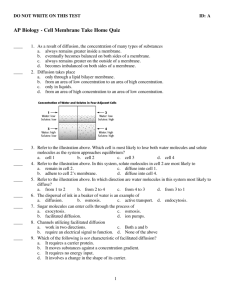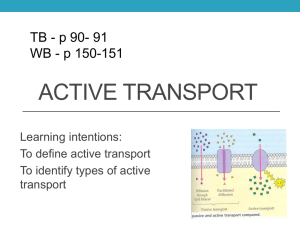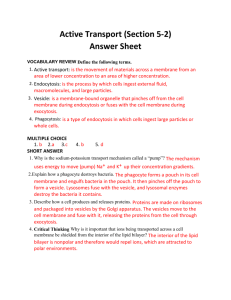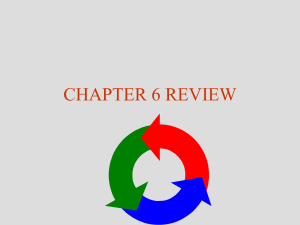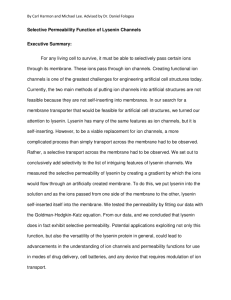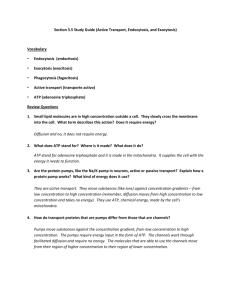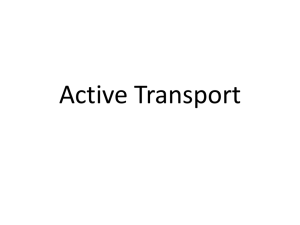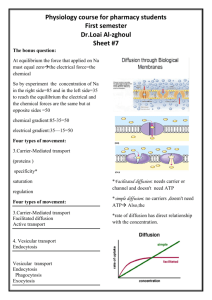Name: Passive and Active Transport Webquest Part 1: Passive
advertisement
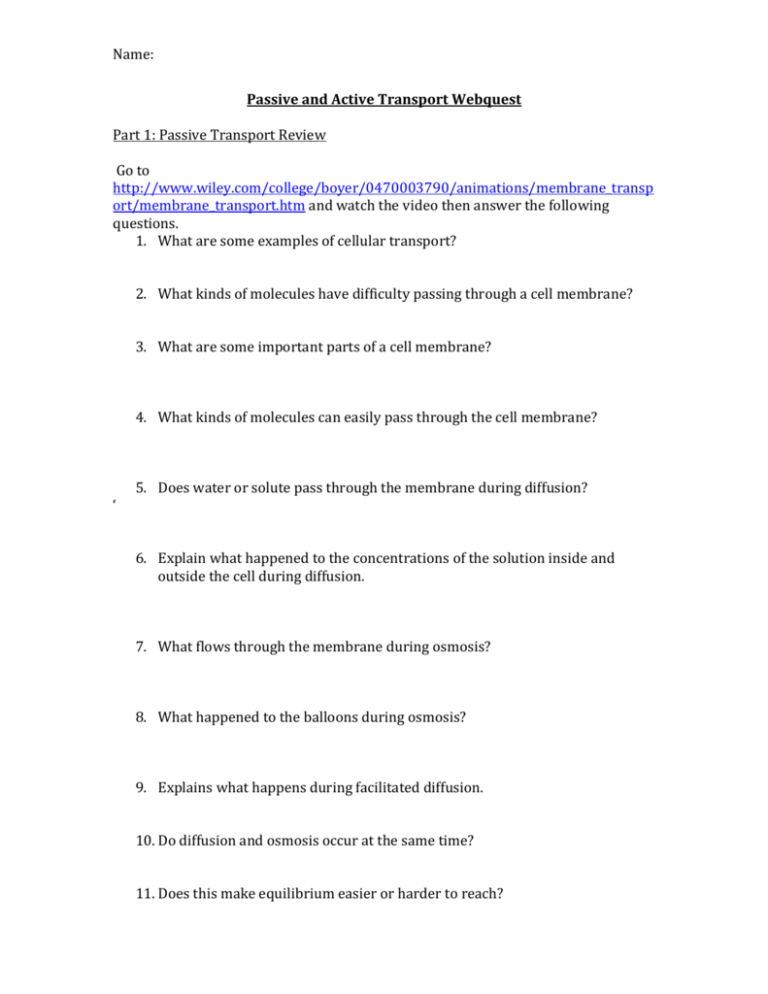
Name: Passive and Active Transport Webquest Part 1: Passive Transport Review Go to http://www.wiley.com/college/boyer/0470003790/animations/membrane_transp ort/membrane_transport.htm and watch the video then answer the following questions. 1. What are some examples of cellular transport? 2. What kinds of molecules have difficulty passing through a cell membrane? 3. What are some important parts of a cell membrane? 4. What kinds of molecules can easily pass through the cell membrane? ‘ 5. Does water or solute pass through the membrane during diffusion? 6. Explain what happened to the concentrations of the solution inside and outside the cell during diffusion. 7. What flows through the membrane during osmosis? 8. What happened to the balloons during osmosis? 9. Explains what happens during facilitated diffusion. 10. Do diffusion and osmosis occur at the same time? 11. Does this make equilibrium easier or harder to reach? Name: Go to http://www.glencoe.com/sites/common_assets/science/virtual_labs/LS03/LS03.ht ml and pick one of the cells to put into the different solutions. Sketch the concentration of the solution and the concentration in the cell and show the direction of water movement. Hypotonic Hypertonic Isotonic Part 2: Active Transport In active transport the cell needs to move ions and molecules against their concentration gradient (low to high) in order to do this the cell needs to use energy in the form of a molecule of ATP to move those ions. There are three main types of active transport: endocytosis, exocytosis, and ion pumps. Use the following websites to gather information on Active Transport. Go to http://www.wisc-online.com/objects/ViewObject.aspx?ID=AP11203 view the animation and answer the following questions. 1. How much of the cell’s ATP will be used for active transport? 2. What is endocytosis? 3. What kinds of things enter the cell through endocytosis? 4. Why do they need to use endocytosis? 5. What is it called when the cell eats (bring in solid particles)? Name: 6. What is it called when the cell drinks (brings in fluid particles)? 7. What is exocytosis? 8. How does exocytosis work? 9. Being that the golgi apparatus usually processes proteins how do you think proteins exit the cell? Go to http://programs.northlandcollege.edu/biology/biology1111/animations/transport 1.html click on active transport and watch the animation and answer the following questions. 1. Why does active transport have to occur? 2. What are ion pumps? 3. What type of macromolecule are they? 4. How do ion pumps work? 5. Being that ion pumps are proteins do you think that they are selective when it comes to the ions that they let across the membrane (much like enzymes and substrates) or do you think they aren’t selective? One important type of ion pump that is responsible for the transmission of nerve signals is the sodium-potassium pump. Go to http://highered.mcgrawhill.com/sites/9834092339/student_view0/chapter44/sodiumpotassium_exchange_pump.html to learn more about this special ion pump. 1. What type of ions does the sodium potassium pump work with? 2. What are sodium potassium pumps responsible for in nerve cells? Name: 3. Watch what happens in the animation and explain how a sodium potassium pump works. Part 3: Analysis questions 1. Why doesn’t passive transport need energy and active transport does? 2. Why do you think cell walls are important in plants? 3. Before refrigeration people salted their food to keep it from spoiling. Why did this work? 4. Carbon dioxide and Oxygen can move freely across the cell membrane. What determines the direction of their movement? 5. In order for oxygen to enter our blood stream our body runs vessels full of deoxygenated (no oxygen) blood across the alveoli (air sacs) that make up our lungs. The oxygen then travels into the blood stream and then is sent back to the heart and then throughout the body to our muscles that are oxygen starved. a. Why does the oxygen enter our blood stream? b. What process does it use? c. Why does the oxygen enter our muscles? d. What process does it use? 6. Sometimes organisms need to maintain a concentration of an ion that is much higher then their surrounding environment. a. What process would the cell use to gain such a high concentration gradient? b. Explain the process that the cell would use to gain that concentration gradient. c. Why couldn’t diffusion be used? Name:
